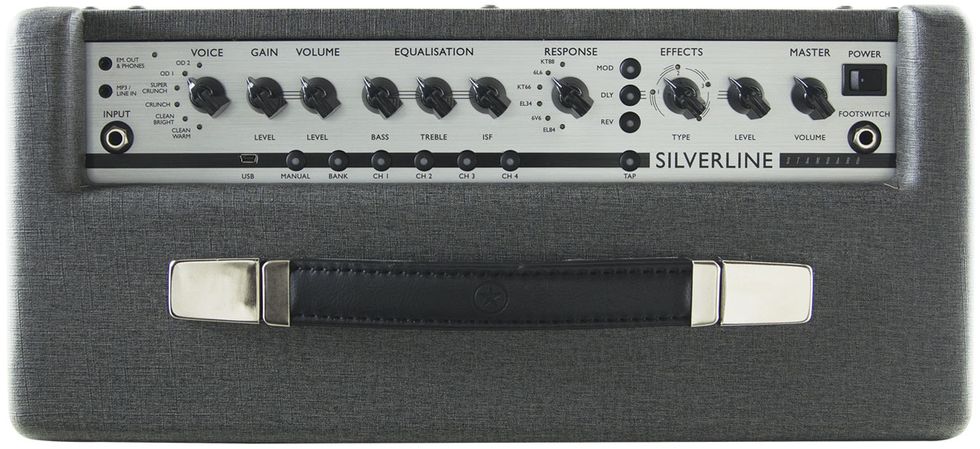RatingsPros:Good sounds. Powerful yet lucid controls. Bargain price. Cons: Amp modeling is a subjective art. Listen before you buy. Street: $429 Blackstar Silverline Standard blackstaramps.com | Tones: Ease of Use: Build/Design: Value: |
Blackstar is best known for creating fire-breathing tube amps in the Marshall vein. That's no surprise, since former Marshall employees founded the company. The amps in Blackstar's new Silverline series breathe fire with the best of them. The tubes, however, are AWOL: They're digital modeling amps.
We reviewed the Silverline Standard, a 20-watt combo with a single 10" speaker. The China-made series also includes the Special (a 50-watt combo) and the Deluxe (a 100-watt model that comes in combo, stereo combo, and head-only models). Power ratings and speaker configurations aside, the features are nearly identical for all Silverline amps.
But they're not identical to rival modeling amps. Blackstar's unique approach yields terrific tones. Sound design is fast and fun. (Honest! Double-pinky-swear!) And given the Standard's $429 price tag, your buck truly bangs here.
A Variety of Voices
Viewed from the front, the Standard looks like a humble retro-style combo amp. An old Supro, maybe? Viewed from above, the top-facing control panel is a mix of modern and idiosyncratic. Gain, volume, bass, and treble knobs do just what you'd expect. There's also a simple effects section, storage slots for 12 saved sounds, and three unusual knobs where most of the sound sculpting occurs.
A “response" control selects from six simulated power-tube modes: EL84, 6V6, EL34, 6L6, KT66, and KT88. The tube models are realistic and strongly differentiated. And even if you're not a tube expert, it's easy to find what you want, since the settings are arranged from the most spongy/compressed to the tightest/cleanest.
Meanwhile, the “voice" control provides six gain settings: two clean sounds (warm and bright), two crunch tones (lighter and heavier), and two overdrive patches (simulated master-volume overdrive and a mid-forward Screamer-type tone). Their characteristics vary according to the response knob setting.
Finally, the “ISF" control transitions from a tight, bright, and scooped blackface Fender flavor to a looser, mid-heavy British vibe.
Simpler Than It Seems
Does that sound complicated? Well, the arrangement does provide seemingly endless options, especially given the controls' interactivity. But in practice, the system is a snap. You might start by dialing in the desired amount of distortion via the voice control, flip through the response settings for the right tightness/looseness, and fine-tune with ISF, without even bothering to read the damn labels. After a few minutes, it all feels organic, musical, and intuitive.
There's no endless scrolling through patches or parameters here. There are only two secondary knob functions: the treble control, which becomes a presence control when you hold the tap-tempo button, and the bass control, which regulates cab resonance when tap-tempo is pressed. Again, it sounds trickier than it is. The layout is logical and ergonomic. You can perform every operation, including the two secondary functions, with a single hand while plucking a reference note on your guitar.

My first demo clip includes a grab bag of tones, each dialed up in about 30 seconds. The second demo clip showcases the 12 factory preset patches. Notice how the single Celestion VT-Junior speaker provides ample highs and thumping lows. Everything was recorded at modest, conversation-level volume. The models are deep and detailed, thanks in part to the Silverline's use of a macho SHARC processor chip. They also respond realistically to stompboxes and other hardware effects upstream from the amp input.
Express Effects
The effects section is equally user-lovin'. There are three effect types (delay, reverb, and modulation, which include flange, phase, tremolo, and chorus), each with an activation button. Adjacent knobs let you choose from four effect settings per category and set the effect levels. (You can use modulation, delay, and reverb separately or simultaneously, but only one effect setting per category.) Again, the ergonomics are superb. You can make adjustments in an instant using one hand. The sound quality is excellent throughout—particularly the gooey spring reverb.
Blackstar offers a free software editor for creating and organizing tones via USB. It's not yet compatible with the latest Mac OS, so I couldn't test it. But judging by the manual, its main benefits are patch organization and storage, a library for backing tracks (the amp has an audio-in jack), a tuner, and stompbox-style effects editors. I'm a total guitar software geek, yet I'm not sure I'd ever connect the Standard to a computer. It's just so darn easy to do everything from the control panel! You can also select patches and toggle effects with Blackstar's $89 FS-10 controller (not included or tested).
The Verdict
Today's guitarist can choose from a vast array of versatile and good-sounding amp modelers. What sets Blackstar's Silverline Standard apart are its attractive amp and effect emulations, its modest price, and a control panel that's ergonomic, easy to understand, and just plain fun to use. The Standard would make a great all-in-one living room amplifier, or a convenient 30-pound gig companion, compact enough for public transportation.
Watch the First Look:









![Rig Rundown: Russian Circles’ Mike Sullivan [2025]](https://www.premierguitar.com/media-library/youtube.jpg?id=62303631&width=1245&height=700&quality=70&coordinates=0%2C0%2C0%2C0)

















